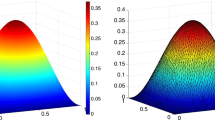Abstract
We derive a posteriori error estimates for two classes of explicit finite difference schemes for ordinary differential equations. To facilitate the analysis, we derive a systematic reformulation of the finite difference schemes as finite element methods. The a posteriori error estimates quantify various sources of discretization errors, including effects arising from explicit discretization. This provides a way to judge the relative sizes of the contributions, which in turn can be used to guide the choice of various discretization parameters in order to achieve accuracy in an efficient way. We demonstrate the accuracy of the estimate and the behavior of various error contributions in a set of numerical examples.







Similar content being viewed by others
References
Ainsworth, M., Oden, J.T.: A posteriori error estimation in finite element analysis. Comput. Methods Appl. Mech. Eng. 142, 1–88 (1997)
Becker, R., Rannacher, R.: An optimal control approach to a posteriori error estimation in finite element methods. Acta Numer. 10, 1–102 (2001)
Delfour, M., Trochu, F., Hager, W.: Discontinuous Galerkin methods for ordinary differential equations. Math. Comput. 36, 455–473 (1981)
Eriksson, K., Estep, D., Hansbo, P., Johnson, C.: Introduction to adaptive methods for differential equations. Acta Numer. 4, 105–158 (1995)
Eriksson, K., Johnson, C., Logg, A.: Explicit time-stepping for stiff ODE’s. SIAM J. Sci. Comput. 25, 1142–1157 (2003)
Estep, D.: A posteriori error bounds and global error control for approximation of ordinary differential equations. SIAM J. Numer. Anal. 32, 1–48 (1995)
Estep, D.: Error estimates for multiscale operator decomposition for multiphysics models. In: Fish, J. (ed.) Multiscale Methods: Bridging the Scales in Science and Engineering, chap. 11. Oxford University Press, New York (2009)
Estep, D., Ginting, V., Ropp, D., Shadid, J.N., Tavener, S.: An a posteriori-a priori analysis of multiscale operator splitting. SIAM J Numer Anal 46, 1116–1146 (2008)
Estep, D., Ginting, V., Tavener, S.: A posteriori analysis of a multirate numerical method for ordinary differential equations. Comput. Methods Appl. Mech. Eng. 223, 10–27 (2012)
Estep, D., Holst, M., Mikulencak, D.: Accounting for stability: a posteriori error estimates based on residuals and variational analysis. Commun. Numer. Methods Eng. 18, 15–30 (2002)
Estep, D., Johnson, C.: The pointwise computability of the Lorenz system. Math. Models Methods Appl. Sci. 8, 1277–1306 (1998)
Estep, D.J., Larson, M.G., Williams, R.D.: Estimating the Error of Numerical Solutions of Systems of Reaction-Diffusion Equations. American Mathematical Society, Providence (2000)
Estep, D.J., Stuart, A.M.: The dynamical behavior of the discontinuous Galerkin method and related difference schemes. Math. Comput. 71, 1075–1104 (2002)
Giles, M., Süli, E.: Adjoint methods for PDEs: a posteriori error analysis and postprocessing by duality. Acta Numer. 11, 145–236 (2002)
Houston, P., Rannacher, R., Süli, E.: A posteriori error analysis for stabilised finite element approximations of transport problems. Comput. Methods Appl. Mech. Eng. 190, 1483–1508 (2000)
Marchuk, G.I., Agoshkov, V.I., Shutiaev, V.P.: Adjoint Equations and Perturbation Algorithms in Nonlinear Problems. CRC Press, Boca Raton (1996)
Petzold, L.R., Ascher, U.M.: Computer Methods for Ordinary Differential Equations and Differential-Algebraic Equations. SIAM, Philadelphia (1998)
Sandelin, J.D.: Global estimate and control of model, numerical, and parameter error. Ph.D. thesis, Colorado State University (2007)
Zhao, S., Wei, G.W.: A unified discontinuous Galerkin framework for time integration. Math. Methods Appl. Sci. 37, 1042–1071 (2014)
Author information
Authors and Affiliations
Corresponding author
Additional information
Communicated by Ralf Hiptmair.
This research is supported in part by the Defense Threat Reduction Agency (HDTRA1-09-1-0036), Department of Energy (DE-FG02-04ER25620, DE-FG02-05ER25699, DE-FC02-07ER54909, DE-SC0001724, DE-SC0005304, INL00120133), Idaho National Laboratory (00069249, 00115474), Lawrence Livermore National Laboratory (B584647, B590495), National Science Foundation (DMS-0107832, DMS-0715135, DGE-0221595003, MSPA-CSE-0434354, ECCS-0700559, DMS-1065046, DMS-1016268, DMS-FRG-1065046), National Institutes of Health (#R01GM096192).
Rights and permissions
About this article
Cite this article
Collins, J.B., Estep, D. & Tavener, S. A posteriori error analysis for finite element methods with projection operators as applied to explicit time integration techniques. Bit Numer Math 55, 1017–1042 (2015). https://doi.org/10.1007/s10543-014-0534-9
Received:
Accepted:
Published:
Issue Date:
DOI: https://doi.org/10.1007/s10543-014-0534-9



